Understanding Possum Nests: Structure and Ecology
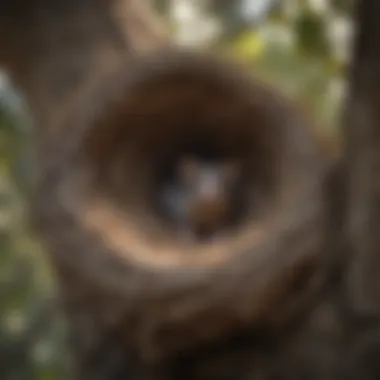
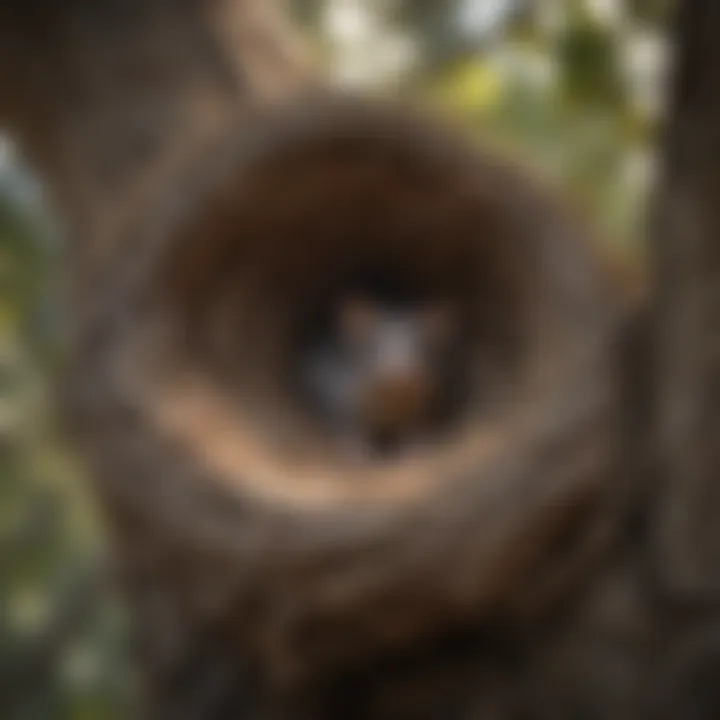
Intro
Possum nests play a critical role in the habitat of these marsupials. Understanding their structure, function, and the implications they have for ecosystems and pest management is essential. This article sheds light on the intricacies of possum nests, how these structures contribute to the overall health of the environment, and why house owners should pay attention to their presence.
Understanding the Pest
Possums are often misunderstood creatures. A basic understanding of their identification and life cycle can enhance our knowledge of how they function in their ecosystems.
Identification
Recognizing possums involves noting their size, color, and distinctive features. Most commonly, the common brushtail possum can be identified by:
- A bushy tail that can be nearly as long as its body
- Large ears and a pointed snout
- A mostly grayish to brown fur
Understanding a possum's behavior is also significant. They are nocturnal, often foraging for food at night. Their eyes appear prominent, adapting well to low light, and they have strong limbs, which allow for agile climbing.
Life Cycle
The reproductive cycle of possums generally spans a year. Female possums typically give birth to one to three joeys after a gestation period of about 17 days. The young spend considerable time in the mother’s pouch, gradually transitioning to the nest. This cycle involves:
- Birth: Joeys are born underdeveloped and immediately crawl into the pouch.
- Growth: The young grow in the pouch for about six months before emerging.
- Independence: After several weeks outside the pouch, joeys will learn to navigate their surroundings before reaching full independence at around six months.
Understanding this life cycle helps us appreciate the nesting behavior of possums, as it is directly linked to the nurturing of their young in a safe environment.
Nest Structure and Materials
Possum nests are constructed using a variety of materials. These can include:
- Leaves
- Twigs
- Bark
- Grass
- Fur
The structural integrity of these nests is vital. They offer protection from predators and harsh environmental conditions. Typically, possums prefer to create nests in tree hollows, but they can also be found in abandoned buildings or under decks in residential areas. The choice of location influences how well the nest can protect their young.
Ecological Significance
Possums play an important role in their ecosystems. They contribute to pest control by eating insects and pests that might harm vegetation. Additionally, their nesting habits promote forest health by assisting in the decomposition of organic matter. This process enriches the soil, enhancing plant growth.
"Possums are essential to the biodiversity of their habitats, often acting as both predator and prey."
Implications for Pest Management
Understanding possum nests is crucial for people dealing with pest management. Effective strategies must consider the ecological role of possums. Displacement of these animals or their nests might seem necessary but can disrupt the local ecosystem. Insight about their structure and nesting patterns can lead to sustainable solutions. For instance, homeowners should consider:
- How to modify the environment to discourage nesting without harming possums.
- Creating physical barriers that can prevent possums from accessing certain areas.
Foreword to Possum Nests
Possum nests are often overlooked yet play a vital role in understanding these nocturnal marsupials. The structure and location of these nesting sites can reveal much about the possum's behavior, survival strategies, and interactions with the environment. For homeowners, knowledge about possum nesting can help in managing potential conflicts and understanding the ecological balance in their area. This article aims to provide insightful information that can enhance awareness of possum nests, thus enriching our appreciation of local wildlife.
Defining Possums
Possums belong to the order Diprotodontia, which is a group within marsupials. They are primarily found in Australia and New Guinea, but some species inhabit other regions as well. Possums such as the Common Brushtail Possum and the Sugar Glider are particularly well-known. Unlike some mammals, possums have a prehensile tail, which aids in climbing and balancing in trees. Their diet is omnivorous; they consume fruits, leaves, insects, and small animals. This dietary flexibility often influences their nesting behaviors.
Overview of Nesting Behavior
Nesting behavior in possums is a critical aspect of their ecology. Possums are known to be arboreal, meaning they prefer to build their nests in trees where they find hollows or dense foliage. This choice offers protection from predators and harsh weather conditions. Depending on the species and available resources, some possums may also nest in ground burrows or artificial structures made by humans.
Their nesting sites are often reused seasonally, which highlights the importance of specific locations in their habitat.
Here are key points about possum nesting behavior:
- Social Structure: Some species may share nests, indicating a social facet to their behavior.
- Seasonal Variations: Nesting choices may change with the seasons; warmer months may see increased nesting in tree hollows.
- Adaptation to Environment: Urbanization has led possums to adapt, using human-made structures for nesting, which emphasizes their resilience and flexibility.
"Understanding the natural behavior of possums is crucial for effective management and conservation strategies."
Through this exploration, we can appreciate the complex interplay between possums and their habitats, which lays the foundation for discussions on specific types of nests, construction materials, and the significant role these nests play within the broader ecosystem.
Types of Possum Nests
The topic of possum nests is significant. It connects to the overall ecology of these animals and impacts human interactions. Possums can create nests in natural and artificial structures. Understanding these types enriches knowledge about their habitat choices and survival strategies. This section discusses both natural and artificial nesting options that possums prefer.
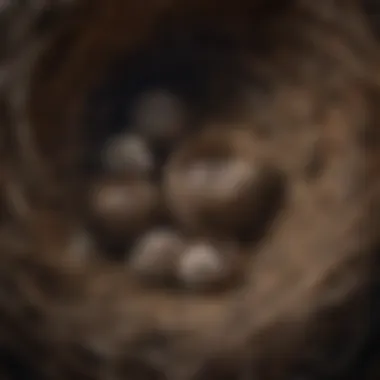
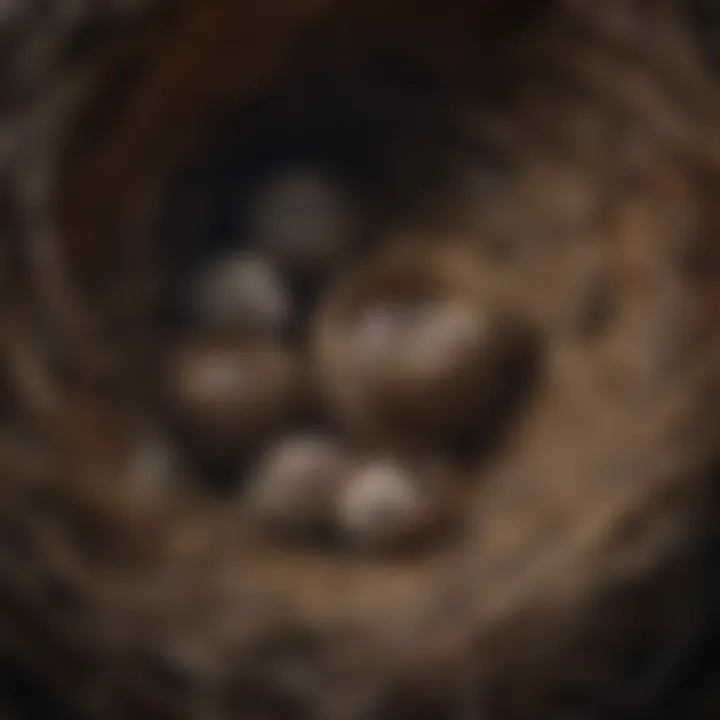
Natural Nest Sites
Natural nests play an essential role in the life of possums. They rely on various sites, each serving unique needs for shelter and safety.
Tree hollows
Tree hollows are one of the most common natural nesting sites for possums. Their cavity structure provides protection from predators. The hollows also maintain a stable temperature, suitable for raising offspring. Possums choose these sites to enhance survival rates. Tree hollows often contain decayed wood and organic matter, which help regulate moisture levels.
However, not all trees are suitable. The availability of hollow trees can vary by region. In places with limited tree coverage, possums might face challenges in finding these vital nesting spots. Thus, loss of woodland areas may directly impact their populations.
Cavities in rocks
Cavities in rocks serve as another important nesting option. These locations offer excellent shelter. The rocks can act as a natural barrier against threats. Moreover, they provide a secluded environment for possums.
Notably, these cavities can be more challenging to find compared to tree hollows. Possums might need to search extensively for suitable rock formations. However, when found, these sites offer significant protection. The main downside is that these locations may not support large colonies like tree hollows do.
Ground burrows
Ground burrows are yet another choice for possum nests. They create these tunnels underground, which allow for concealment and avoid potential dangers. Such nests can be particularly advantageous in urban settings where overhead structures are scarce.
The unique feature of ground burrows is their accessibility. Possums can quickly escape to safety by utilizing these passages. However, this method can come with risks, such as flooding or being predated upon by ground animals. Ground nesting is also less common and might not be suitable for all possum species.
Artificial Nest Structures
Artificial structures have changed the way possums seek shelter, especially in urban environments. These nests highlight adaptability in urban settings where natural habitats are declining.
Man-made shelters
Man-made shelters offer various possibilities for possums. They include sheds, pet houses, or even purpose-built possum homes. They provide a safe environment against extreme weather and predators. The advantage is clear: these shelters can be placed in optimal locations for food and safety.
However, these shelters need to be maintained. Poorly constructed homes can lead to safety issues for the possums. Without proper care, these spaces can also become breeding grounds for diseases.
Roofs and attics
Roofs and attics often attract possums due to their shelter potential. These areas have minimal human oversight, offering a clandestine nesting space. Possums favor these warm spots, especially in colder climates.
While attics can be advantageous, they also pose problems. Common issues include damage to property or health concerns because of potential zoonotic diseases. If not managed correctly, conflicts between humans and possums rise from this nesting choice.
Garages and sheds
Garages and sheds are another common nesting area for possums. These spaces provide an usually dark and secluded environment. Garages may have various items for potential bedding materials, making them attractive.
Yet, these spaces can create problems for homeowners. Possums can damage materials and cause disturbances. It is crucial to educate homeowners on managing these interactions without harming the animals. By recognizing the benefits and drawbacks of each nesting type, individuals can foster a better coexistence with possums.
Construction Materials for Possum Nests
Understanding the construction materials used by possums for their nests is vital for appreciating their nesting behavior and their role in ecosystems. The materials possums choose affect not only the structure and durability of the nests but also their comfort and safety. This section will delve into both natural and human-related materials, examining their characteristics, advantages, and drawbacks.
Natural Materials
Natural materials are essential in the construction of possum nests. They provide insulation, protection from the elements, and a safe environment for raising young.
Leaves and twigs
Leaves and twigs are fundamental materials in possum nest construction. They are easily accessible and abundant in natural habitats. The key characteristic of leaves and twigs is their lightweight nature. This makes them manageable for possums to gather and arrange.
The unique feature of leaves is their ability to provide good insulation. They trap heat effectively, maintaining a stable temperature within the nest. However, their disadvantages include susceptibility to decay and potential pest attraction.
Moss and lichens
Moss and lichens serve as excellent natural insulators for possum nests. Their characteristic is their moisture-retaining capability, which can benefit possums in arid environments. Moss is particularly popular due to its spongy texture, which adds comfort to the nest.
One noteworthy advantage is that these materials naturally deter some pests, promoting a safer nesting environment. However, a disadvantage is that they require a specific humidity level to thrive, limiting their availability in certain regions.
Animal fur
Animal fur is another choice for possums, providing warmth and softness. The key characteristic of animal fur is its thermal efficiency. It keeps the nest cozy during cold nights. Possums often repurpose fur from their previous nesting sites or from animals they encounter.
The unique feature of fur is its ability to wick moisture away, preventing nest rot. However, a disadvantage is that scavenging for fur may lead to potential contamination from parasites or pathogens.
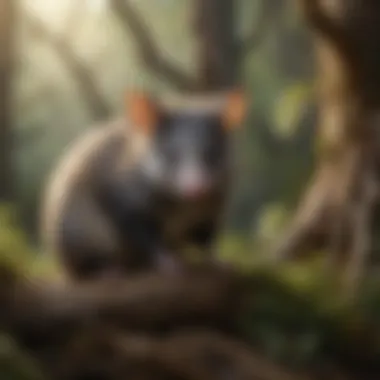
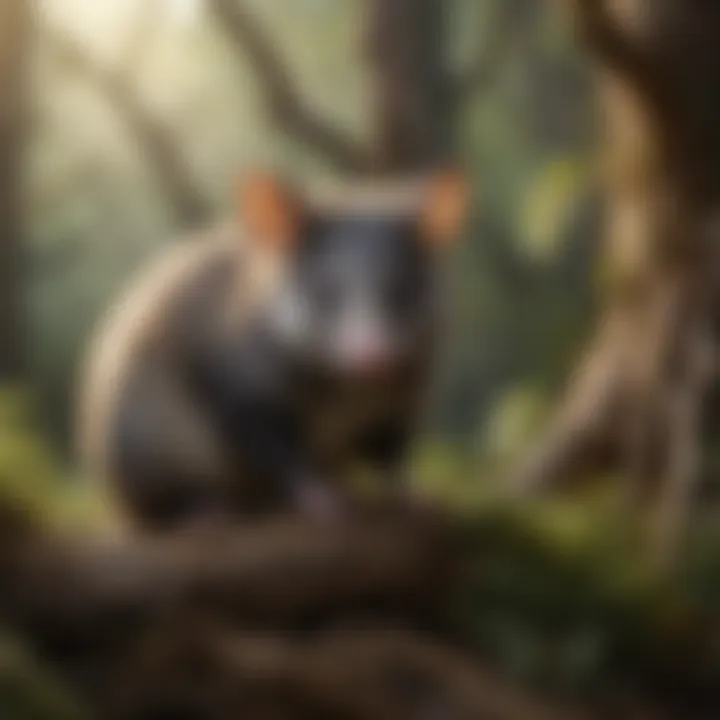
Human-Related Materials
Human-related materials are becoming increasingly common in possum nests, reflecting their adaptability to urban environments. These materials have gained significance due to their practicality and availability.
Insulation
Insulation, commonly found in buildings, is often utilized by possums for its beneficial properties. Its key characteristic is its ability to regulate temperature effectively. Possums can use it to create a warm and insulated nesting area.
While insulation is quite effective, it presents a disadvantage in terms of human conflict. The use of insulation in nests might influence urban wildlife management strategies, complicating interactions between possums and homeowners.
Cardboard and paper
Cardboard and paper are readily available materials that possums often incorporate into their nests. Their key characteristic is lightweight, making them easy for possums to carry.
These materials offer advantages such as ease of manipulation and insulation properties. However, disadvantages include susceptibility to moisture damage, which can compromise the nest's structure over time.
Plastic debris
Plastic debris, though not a natural choice, is found in many urban settings. The key characteristic of plastic is its durability. Possums often use it to reinforce their nests or as a moisture barrier.
Though it serves as a strong nest component, a significant disadvantage is its environmental impact. The reliance on plastic poses risks to the ecosystems and can lead to unintended consequences, like ingestion by wildlife. This underlines the importance of understanding the effects of human activity on wildlife nest behaviors.
Overall, the use of both natural and human-related materials reflects the adaptability of possums. This aspect emphasizes their resilience in the face of changing environments.
Environmental Factors Influencing Nest Selection
Understanding the environmental factors influencing nest selection among possums is essential not only for grasping their nesting behavior but also for comprehending their role in the ecosystem. This section delves into the components that affect how possums choose their nesting sites, focusing on availability of resources and climate considerations. Each of these elements highlights the adaptations possums have made to survive and thrive in diverse environments.
Availability of Resources
Food sources
Food is fundamental for possums. They typically prefer areas rich in flora, which provide not only nutrition but also shelter. Possums are herbivores, often feeding on leaves, fruits, and flowers. The key characteristic of food sources is their availability during different seasons. This requirement makes it necessary for possums to select nesting sites near productive feeding grounds, ensuring a stable food supply.
This choice also has unique features. Areas with abundant food resources generally offer a complex ecosystem, supporting various plant types, which further aids in creating a suitable habitat. However, competition for food can be a disadvantage, as it may lead to increased interactions with other species.
Water proximity
Water plays a crucial role in possum nesting. Proximity to water sources is important as it affects hydration needs and influences food production in the area. A key element of water proximity is that it supports vegetation, which in turn provides food and shelter for possums. When possums select nests near water, they ensure easier access to hydration and food sources.
However, being too close to water can pose risks, such as flooding during heavy rainfall. The balance of having sufficient water access without the threat of flooding is a vital consideration in nest selection.
Safety from predators
Safety from predators is a significant aspect when possums choose their nests. The key characteristic of this factor lies in how well the nesting site offers concealment from potential threats. Possums often select locations that are elevated or have dense vegetation, thereby reducing the visibility to predators such as owls or rodents.
The unique feature here is that nests positioned in inaccessible areas or those camouflaged effectively enhance survival. On the other hand, high predator activity in particular environments might lead possums to relocate or adjust their nesting patterns to seek better safety.
Climate Considerations
Temperature regulation
Temperature regulation is vital for possum survival. Possums need to maintain their body temperature to function properly. The selection of nests that provide adequate thermal regulation ensures they are neither too hot nor too cold. A key characteristic is the positioning of nests in shaded areas during summer to avoid overheating, while also finding spots that provide warmth during winter.
This consideration is essential for their metabolic processes. An insufficient temperature control mechanism can impair their health and overall functionality, making this a central focus in their nesting choices.
Moisture control
Moisture control is another critical factor affecting nesting sites. Possums require dry environments to prevent issues such as fungal infections or other health risks. The ability to select a nest that offers proper drainage is beneficial, as it helps maintain a comfortable habitation. A key aspect is that nests located in areas with high foliage tend to retain moisture better, but this can also lead to increased humidity levels.
Possums often adapt by selecting elevated positions or choosing nests that avoid excessive dampness. While moisture control presents opportunities for comfort, excessive moisture could lead to health problems, thus influencing their nesting decisions.
Shelter from elements
Lastly, shelter from environmental elements represents an essential factor in nest selection. Possums need protection from adverse weather, such as rain, wind, or extreme temperatures. The key characteristic of effective shelter is its design, which often involves structures that can shield them efficiently.
The unique feature here is that nests offering consistent shelter generally contribute to a possum's overall health and reproductive success. However, areas that are overly shielded might limit access to light and food, creating a trade-off in their nesting decision-making process.
Importance of Possum Nests in Ecosystems
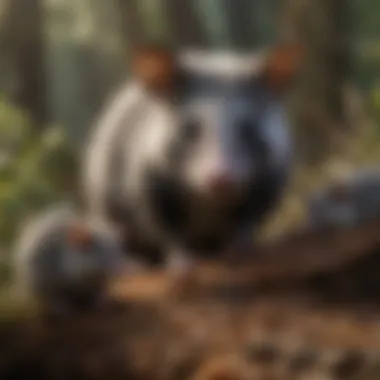
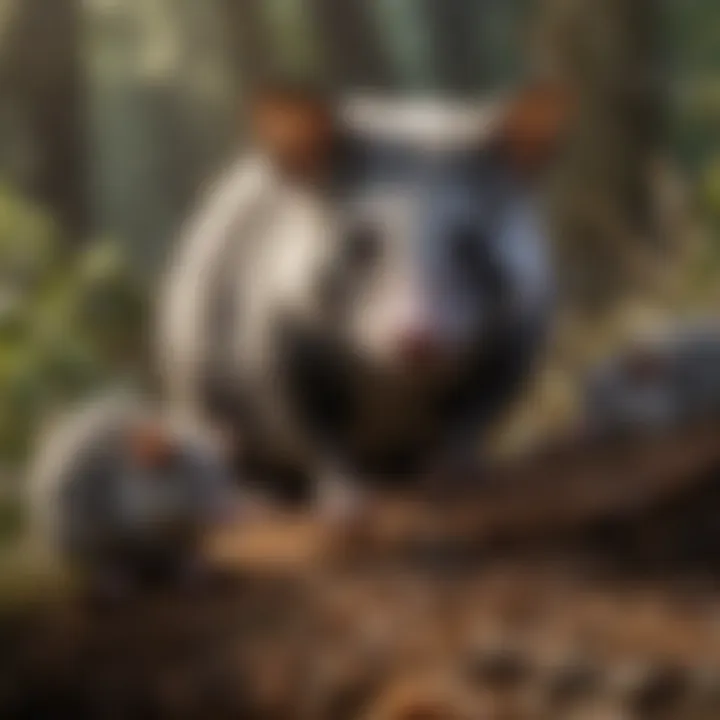
Possum nests play a vital role within ecosystems, impacting various ecological processes. Recognizing how these nests contribute to the environment offers insights into their broader significance. Possum nests are not just simple structures; they serve multiple functions that benefit both the possums and other species that coexist within their habitats.
Role in Biodiversity
Support for Other Species
Possum nests provide shelter for a range of other animals. Many small birds and insects find refuge in the abandoned nests, promoting a community of various organisms. The ability of these nests to support multiple species enhances biodiversity. This is particularly important in urban areas, where natural habitats are diminishing. Nesting support allows animal populations to thrive and maintain ecological balance.
Nutrient Cycling
Possums contribute to nutrient cycling through their nesting behavior. As they use leaves and other organic material to construct nests, they facilitate the decomposition process. Decayed plant matter enriches the soil, which can support plant growth. This cyclical process is crucial for sustaining healthy ecosystems. It leads to improved nutrient availability in the environment.
Habitat Provision
Possum nests also serve as critical habitats. The structure and location of these nests provide protection from predators. Therefore, they are integral for survival and reproduction of possums and other small creatures. The varied types of nests, whether natural or artificial, offer choices for different species. This variety increases habitat availability across different landscapes, fostering a diverse ecosystem.
Impact on Pest Control
Natural Predation
Possums are natural predators of various pests. Their presence in an ecosystem helps control insect populations, which can be vital for agricultural practices. By preying on pests, possums reduce the need for chemical pesticides. This method of pest control is safer for the environment and supports biodiversity. However, reliance on possums alone is not a complete solution, as other natural factors must complement this predation.
Competition with Other Pests
Possums can compete with other pest species for resources. This competition can help to keep pest populations in check, thus benefiting farmers and homeowners. By limiting the presence of more harmful pests, possums support a balanced ecosystem. However, this competition could sometimes have unintended consequences, creating an imbalance if the possum population becomes too high.
Food Web Dynamics
The role of possums in food web dynamics is essential for understanding ecological relationships. As consumers, they fit into a complex web of interactions between producers and higher-level predators. Their foraging activities help distribute seeds and disperse nutrients, enhancing the overall health of the ecosystem. Nevertheless, the impact of possums on food webs varies depending on the specific environment and species involved.
The presence of possum nests is not merely an aspect of wildlife observation; it reflects deeper ecological interactions crucial for ecosystem health.
Understanding these components is critical for effective management of both possums and their habitats. Recognizing the integral role of possum nests can motivate better conservation practices, ultimately benefiting the overall environment.
Human-Possum Interactions
Human interactions with possums are a significant aspect of understanding their behavior and habitat. As these animals adapt to urban settings, it becomes essential to examine how these interactions affect both the possums and the communities they inhabit. Urban adaptation presents unique challenges and opportunities, especially regarding how possums establish nests in man-made environments. This section covers the dynamics of human-wildlife conflict and also highlights management strategies that balance human interests and possum conservation.
Urban Adaptation of Possums
Nest establishment in urban areas
Nest establishment in urban areas is a prevalent behavior among possums. As cities expand, possums find suitable habitats in attics, gardens, and various other human-made structures. This adaptation allows them access to food and shelter but also brings them closer to human populations. Key characteristics of nest establishment include the utilization of pre-existing structures that provide safety and warmth. This choice is beneficial because it allows possums to thrive in environments with fewer predators. However, urban settings also expose them to dangers like vehicle traffic and human disturbances.
Human-wildlife conflict
Human-wildlife conflict is another critical aspect of possum interactions. As possums venture into urban areas, they can become a nuisance by raiding garbage or causing damage to homes. This conflict often leads to negative perceptions among residents. The key characteristic here is that conflicts arise from competition for resources. While possums play a role in pest control by eating insects, their presence can disrupt household routines. Addressing this issue demands a delicate balance. Overcoming human-wildlife conflict requires education about possum behavior and implementing strategies to minimize encounters. This ensures both possums and humans can coexist with reduced friction.
Management and Control Strategies
Prevention of nesting
Prevention of nesting is an approach to managing possum populations in urban environments. By removing potential nesting sites, homeowners can deter possums from establishing residences in unwanted areas. The key characteristic of this strategy is proactivity. Making roofs less accessible and sealing entry points are effective methods. However, it is essential to understand that while prevention can reduce conflicts, it may not eliminate them entirely. Homeowners must balance preventative measures with compassion for wildlife, as possums are vital for ecological health.
Humane relocation
Humane relocation is an alternative for dealing with possums that have established nests in undesirable locations. This method involves safely capturing and relocating possums to areas where they can thrive without causing disputes. The key feature is that it prioritizes animal welfare. Humane methods often include using specially designed traps that do not harm the animals. However, the disadvantage is that relocation can be resource-intensive and may not always solve the underlying problem of resource competition. Community education about possum behavior can complement humane relocation and promote coexistence.
Monitoring and research
Monitoring and research are crucial for understanding possum populations and their impact on urban landscapes. By studying possum habits, researchers can inform management strategies and help communities make educated decisions. The key characteristic of this approach is data collection, which can reveal trends and behaviors essential for effective wildlife management. However, the challenge lies in funding and maintaining long-term studies. Knowledge gained from ongoing research can lead to better understanding and appreciation of possum roles in our environments.
Ending
The conclusion serves as a critical component of any article, especially one that delves into the complex subject of possum nests. In this context, it carries substantial weight as it wraps up the essential findings and insights gathered throughout the discourse. By summarizing the key elements discussed earlier, the conclusion reinforces the relevance of possum nests not just for the animals themselves, but also their significant implications for broader ecological and pest management considerations.
Summary of Key Points
In this article, we examined various aspects of possum nests, which are integral to understanding their role in ecosystems. Here is a brief overview of the key points covered:
- Definition and Overview: We defined what possums are and looked into their nesting behavior, which varies significantly across species.
- Types of Nests: Different nest types, including natural sites like tree hollows and artificial structures created through human development, were discussed.
- Construction Materials: The materials used by possums to construct their nests, both natural and human-related, highlight their adaptability.
- Environmental Influences: Availability of resources such as food, water, safety, and climatic factors were considered essential for nest selection.
- Ecological Importance: We explored how possum nests contribute to biodiversity and pest control within ecosystems.
- Human Interactions: The article examined the dynamic relationship between possums and humans, showing how urbanization affects possum behavior and nest establishment.
Future Research Directions
Future research on possum nests should address several important areas to broaden our understanding:
- Behavioral Studies: Investigating how possums adapt their nesting behavior in urban environments can provide insights into wildlife management strategies.
- Influence of Climate Change: Understanding how environmental changes impact nesting locations could inform conservation efforts.
- Longitudinal Studies: Researching how the presence of possum nests affects local ecosystems over time can reveal the long-term ecological roles these nests play.
- Human Impact Assessment: Further studies could examine the effectiveness of various management strategies on reducing human-wildlife conflicts related to possums.







